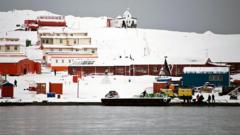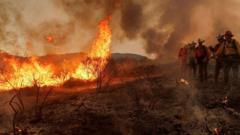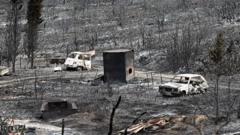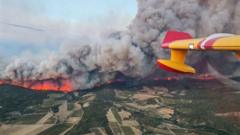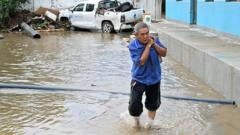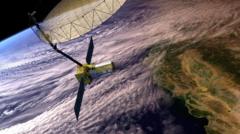Recent findings indicate glaciers are melting at unprecedented rates, emphasizing the urgency of addressing climate change to mitigate future impacts.
**Accelerating Glacier Meltdown: A Call for Urgent Climate Action**

**Accelerating Glacier Meltdown: A Call for Urgent Climate Action**
A comprehensive study reveals the rapid decline of the world's glaciers, posing severe implications for freshwater supply and global sea-level rise.
The world's glaciers are experiencing an alarming rate of melting, the fastest ever recorded, according to a groundbreaking study published in the journal *Nature*. This extensive analysis, combining over 230 estimates from 35 different research teams, illustrates the profound impact of climate change on these frozen rivers of ice, which provide a crucial freshwater resource for millions and hold enough water to increase global sea levels by approximately 32 cm (13 inches) if completely melted.
Since the early 2000s, the world's glaciers have lost more than 6,500 billion tonnes of ice, equating to 5% of their total mass. The study highlights an accelerated pace of melting, with recent decade losses surpassing those from 2000 to 2011 by over one-third. Michael Zemp, director of the World Glacier Monitoring Service and lead author of the analysis, emphasized that the annual ice loss of 270 billion tonnes could satisfy the global population's water needs for 30 years, illustrating the stark reality of glacier depletion.
The research indicates that glaciers serve as critical indicators of climate change stability. Optimal conditions would see glaciers maintain their size through a balance of snowfall and melting, yet rising temperatures, driven primarily by human activities like fossil fuel combustion, have led to consistent shrinkage over the past two decades. Central Europe has faced particularly severe consequences, with a staggering 39% ice loss in just over two decades.
The innovative aspect of this study lies not in discovering that glaciers are melting but in bringing together various methodologies for data collection. These methods include field measurements and different types of satellite observations, which, despite their individual limitations, combine to provide a more accurate portrayal of global glacier dynamics. The collaborative nature of this research serves to bolster confidence in the findings and their implications for policymakers and climate scientists alike.
The results shed light on the need to act urgently. The future of the glaciers, and consequently the amount of ice lost by the close of the century, hinges on humanity’s approach to carbon emissions. Current climate models suggest that achieving established global warming targets could prevent a loss of a quarter of the world's glacier ice, while failing to act might result in nearly half of it disappearing.
As Prof. Zemp poignantly notes, the repercussions of glacier melt extend beyond mere regional changes; they threaten the well-being of hundreds of millions who rely on glacier meltwater for their livelihoods. The disappearance of these glaciers would eliminate a vital water supply, leading to severe resource challenges.
Furthermore, the rise in global sea levels, already heightened by over 20 cm (8 inches) since 1900 with rapid increases noted since the early 1990s, further compounds the crisis. Each centimeter of sea-level rise can expose an additional 2 million people to annual flooding risks, a reality that underscores the interconnectedness of climate phenomena.
In conclusion, addressing the accelerating melt of glaciers is crucial not only for environmental preservation but also for safeguarding future water supplies and preventing catastrophic flooding in vulnerable regions. The findings compel immediate action to curb greenhouse gas emissions and implement sustainable practices that could mitigate the irreversible damage already underway.
Since the early 2000s, the world's glaciers have lost more than 6,500 billion tonnes of ice, equating to 5% of their total mass. The study highlights an accelerated pace of melting, with recent decade losses surpassing those from 2000 to 2011 by over one-third. Michael Zemp, director of the World Glacier Monitoring Service and lead author of the analysis, emphasized that the annual ice loss of 270 billion tonnes could satisfy the global population's water needs for 30 years, illustrating the stark reality of glacier depletion.
The research indicates that glaciers serve as critical indicators of climate change stability. Optimal conditions would see glaciers maintain their size through a balance of snowfall and melting, yet rising temperatures, driven primarily by human activities like fossil fuel combustion, have led to consistent shrinkage over the past two decades. Central Europe has faced particularly severe consequences, with a staggering 39% ice loss in just over two decades.
The innovative aspect of this study lies not in discovering that glaciers are melting but in bringing together various methodologies for data collection. These methods include field measurements and different types of satellite observations, which, despite their individual limitations, combine to provide a more accurate portrayal of global glacier dynamics. The collaborative nature of this research serves to bolster confidence in the findings and their implications for policymakers and climate scientists alike.
The results shed light on the need to act urgently. The future of the glaciers, and consequently the amount of ice lost by the close of the century, hinges on humanity’s approach to carbon emissions. Current climate models suggest that achieving established global warming targets could prevent a loss of a quarter of the world's glacier ice, while failing to act might result in nearly half of it disappearing.
As Prof. Zemp poignantly notes, the repercussions of glacier melt extend beyond mere regional changes; they threaten the well-being of hundreds of millions who rely on glacier meltwater for their livelihoods. The disappearance of these glaciers would eliminate a vital water supply, leading to severe resource challenges.
Furthermore, the rise in global sea levels, already heightened by over 20 cm (8 inches) since 1900 with rapid increases noted since the early 1990s, further compounds the crisis. Each centimeter of sea-level rise can expose an additional 2 million people to annual flooding risks, a reality that underscores the interconnectedness of climate phenomena.
In conclusion, addressing the accelerating melt of glaciers is crucial not only for environmental preservation but also for safeguarding future water supplies and preventing catastrophic flooding in vulnerable regions. The findings compel immediate action to curb greenhouse gas emissions and implement sustainable practices that could mitigate the irreversible damage already underway.



